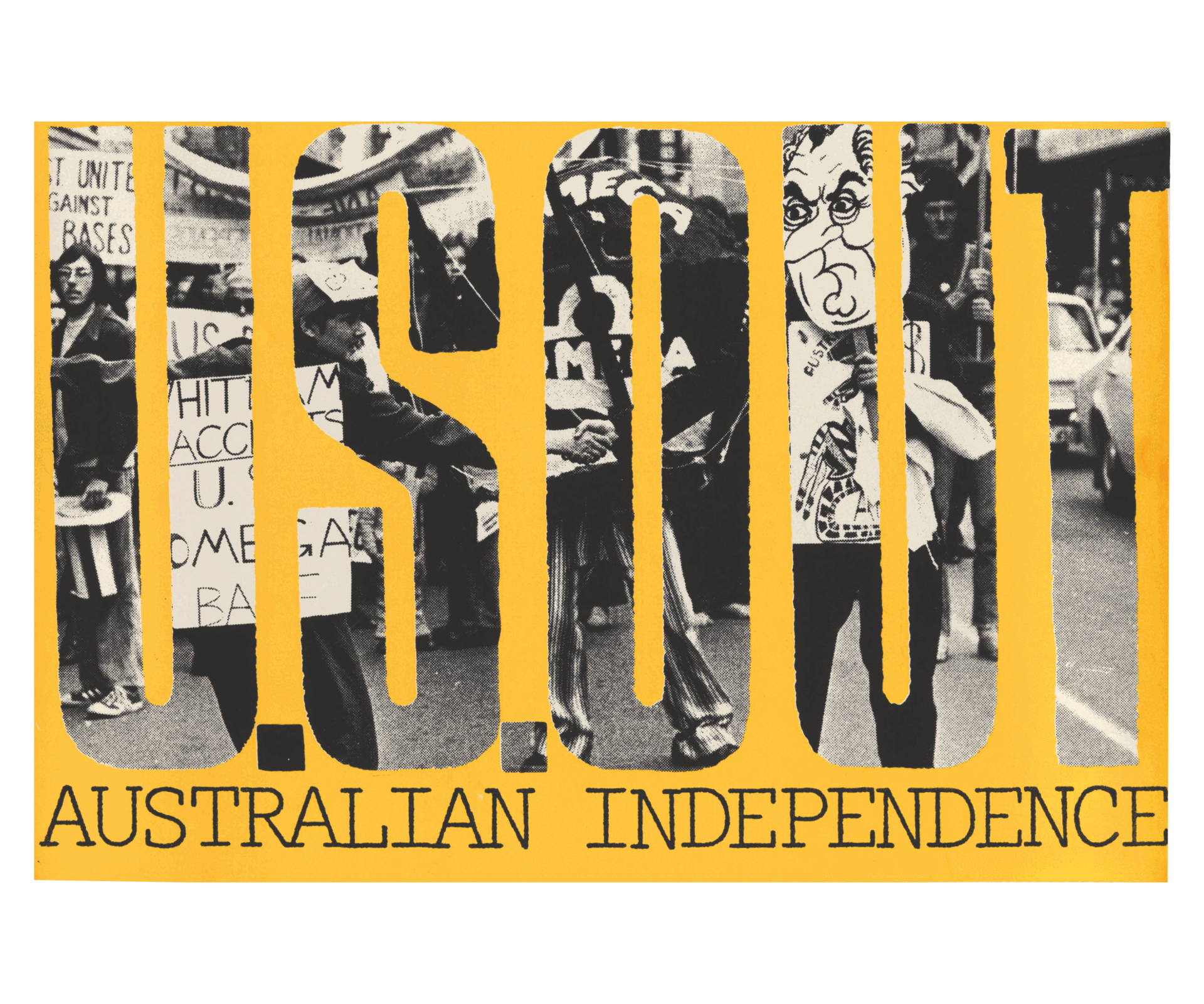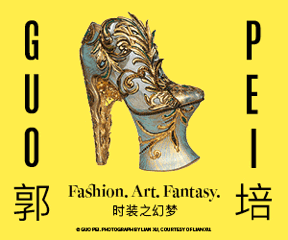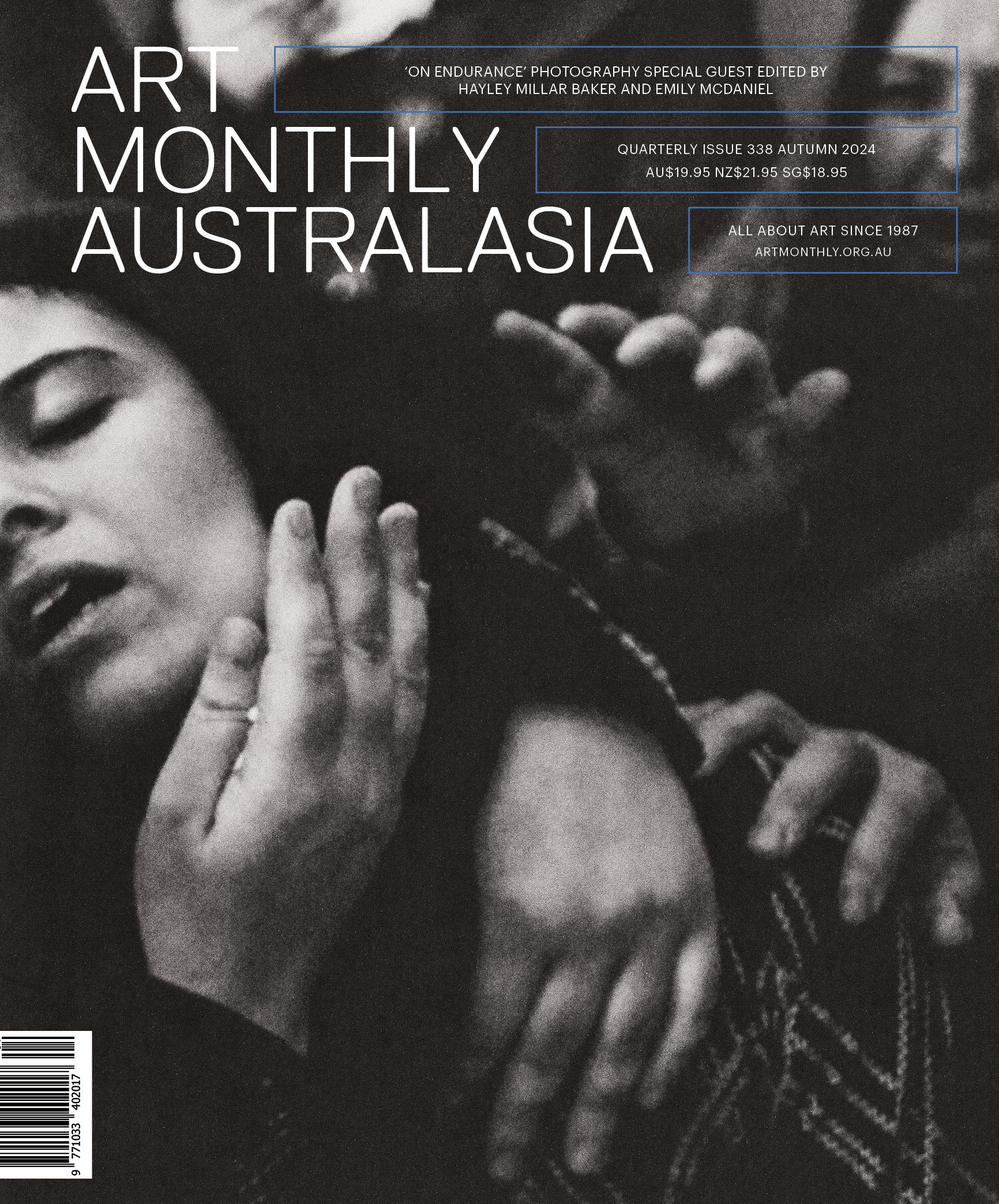September 2008 Issue 213
1 Back to the future? – 2008 Biennale of Sydney: MICHAEL DESMOND
Chen Xiaoyun (China), A Mythical Wild Animal?? Symbol of Durance, 2008, video, colour, sound. Courtesy the artist
According to the Artistic Director of the 2008 Biennale of Sydney, Carolyn Christov-Bakargiev, ‘Revolutions – Forms that turn articulates the agency embedded in forms that express our desire for change’. Given the emphasis on change and of overthrowing the established order, there is a perversity in bringing back the art of several decades ago. The 2008 Biennale mixed art made in the last ten years with the art of high modernism, the art of the 20th century. This ranges from a photograph made in 1900 to works of classic modernism by Kasimir Malevich of 1915, or Luigi Russolo of 1911. Christov-Bakargiev explains that this mix is another aspect of revolution, that things revolve, i.e. that art cycles like the forms that turn, first disappearing then returning renewed. For those weary of novelty, wanting to finally embrace postmodernism with its relativistic tendencies and historical footnotes and an exhibition based around art and less concerned with high-brow theory or moral turpitudes – this exhibition promised much
2 East and West? A different story: the impact of Mexico on 20th century Asian art: ALISON CARROLL
Carlos V. Francisco, Victorio Edades and Galo Ocampo, State Theatre Mural, 1935 (detail), Manila. Images collection of Victorio Edades
It is accepted universally that the world splits through the Pacific. There is a date line knifing down, where travellers lose and gain time – an unheard of concept for the rest of the Westernised world. In the past, the Pope started the idea with the Treaty of Tordesillas of 1494, expanded in 1529 to divide the world through this misty line, allocating colonial possessions (if they could be got) to the Portuguese and Spanish depending on their geographic relation to it. Today, the Pacific Ocean looms as one of the last great unknowns, a huge area to be flown over, with grateful reference to a few islands on which to either land to refuel, or aim towards if shipwrecked
3 Letter from Manila: GINA FAIRLEY
Wawi Navarroza, Still Missing (You), 2007, archival pigment ink color photograph on artist premium canvas. Image courtesy the artist
Regardless of how often I visit Manila, I am always bowled over by the pace of its art scene and its undeniable fracture. This ricochet one feels as an outsider is partly due to the sheer impenetrability of Manila’s urban landscape but also the blinding number of shows that demand one’s attention
4 A Century of Focus: South Australian Photography 1840s – 1940s: TANYA COURT
C. R. Marlow, Australia (1854 – 1919), Picnic at the beach, 1890s, albumen-silver photograph (cabinet card). R.J. Noye Collection. Gift of Douglas and Barbara Mullins 2004. Courtesy Art Gallery of South Australia, Adelaide
As a landscape architect I am interested in the representation of landscape and how this is also manifested in the constructed landscape. Is ‘faithful recording’ possible? What are the possibly unique qualities of photography that this ‘new process’ was able to bring to the representation of landscape? Was the ‘wonder’ of the new process equal to capturing the ‘wonder’ of a new landscape unfolding at the same time to colonial settlers? A review of the recent exhibition, A Century in Focus: South Australian Photography 1840s – 1940s, will be used as a lens, narrowing the aperture, to consider the photographic depiction of the unique qualities of particular landscapes, especially in regard to their role in recording ‘time’. Photographs are static but they are not motionless. Where is this motionlessness evident in the exhibition? Is it in the space between the image and the dynamic ‘reality’ of the landscape? While the photographs are aesthetic objects in their own right, they are also contextualised records of progress and process, providing critique and commentary on our own time as well as their own. The same concerns resonate through contemporary debates about landscape architectural representation and practice
5 Art-Speak: CHRISTOPHER JOHNSTONE, Auckland
Joyce Campbell, Mindanao 1, 2002,, ilfochrome photograph mounted on aluminium. The University of Auckland Art Collection
In New Zealand any 125th anniversary is worth noting since the country is officially only 158 years old. The celebration of the establishment of the University of Auckland in 1883 as a constituent college of the University of New Zealand is being marked, amongst other events, by an exhibition of the university’s art collection titled Art-Speak
6 Geoffrey Goldie (1921 – 2007): SAM SCHOENBAUM
Geoffrey Goldie, Self-portrait, 1946, oil on canvas. Courtesy the artists estate
The Australian artist Geoffrey Goldie was born on 14 November 1921, into a farming family in Port Fairy, a fishing village in Victoria. As a gifted child he pursued his interest in the visual arts with encouragement from his family. He began art study in a regional tertiary institute. After six years in the Australian army he returned to his studies (1947-49) in Melbourne with the modernist painter, George Bell, who emphasised form and structure. Goldie’s art was included in a 1992 exhibition, Classical Modernism: The George Bell Circle, at the National Gallery of Victoria. The human figure, interiors, and still lifes in a cubistic style carried the look of the time
7 Letters
An Open Letter to the
Prime Minister of Australia
Re: The Australia Council
Dear Prime Minister Rudd
Recently my work was invited to participate in the Guangzhou Triennial at the Guangdong Museum of Art in China. This is an important invitation coming from curators with international reputations. The organisers asked me to assist them in looking for funding as they have limited government support.
The Visual Arts Board (VAB) of the Australia Council for the Arts informed me that I was unable to apply directly for support through the appropriate category (Out of Time). The reason given was that the VAB only allows one application by an individual artist per year. As I had not made any applications to the VAB this year I was surprised to be ruled ineligible. Yes Minister came to mind when the VAB informed me that the unsuccessful application I submitted 16 months ago (April 2007) is considered by the VAB to be an application this year. Absurdly this restriction requires artists to know what future invitations will arrive to remain eligible
read more #213
8 Through a glass darkly: CHRISTOPHER HEATHCOTE
Rick Amor: A Single Life Museum of Modern Art at Heide, 22 March to 13 July 2008. Gavin Fry: Rick Amor Beagle Press, 216 pp, $120 rrp
Creativity is a self-generating, self-absorbing human state. Much as strong novelists write because they are obsessive readers, so, too, will strong artists paint because they are compulsive viewers, and – if my visits to painters’ homes are sufficient to go by – they prefer to dwell in image lined habitats. Setting the agenda for the high modernist twenties, the British poet-cum-critic T. S. Eliot tried to theorise this condition via his celebrated essay Tradition and the Individual Talent (1919), which suggested that every maker is caught up in a dialogue with existing creative texts. A half-century later, the idea was rejigged by budding postmodernists including the Yale scholar Harold Bloom whose landmark book, The Anxiety of Influence (1973), categorised how creators respond to their forebears, and the New York curator Douglas Crimp who, in a turgid, much anthologised essay, ‘Pictures’ (1979), boiled it all down to a catchy slogan: ‘beneath every picture is another picture’
9 Joanna Woods Facing the Music: Charles Baeyertz and the Triad: DAMIAN SKINNER
Joanna Woods, Facing the Music: Charles Baeyertz and the Triad, Otago University Press, 2008, 247 pages, $45 rrp.
We all know it shouldn’t be done, but I’d like to begin by judging Joanna Woods’s Facing the Music: Charles Baeyertz and the Triad by its cover. On the front is a photograph of the man himself, in which Baeyertz is every bit the confident and successful critic and magazine publisher, his suit and bow tie signifiers of his material success, and the not-quite-smile on his face revealing his legendary steely commitment to excellence and to making judgments public, regardless of the personal cost. On the back of the book, a pictorialist photograph titled Melisande, which was the Triad’s centrefold in August 1918, reveals a now somewhat coy but no doubt then daring nude female poised on a rock and staring at her reflection in the tranquil water. Nicely complicating our reading of this image is a quote from Charles Baeyertz: ‘This magazine . . . is made to sell.’ Like Melisande on her rock, nudity in the Triad is balanced between an avant-garde challenge to middle-class taste and a fairly direct appeal to the (male) desires of that same market. Welcome to the world of Baeyertz and the Triad
10 Yiloga: Tiwi Footy, MARGIE WEST
Yiloga: Tiwi Footy F11 Productions, Darwin, 2008, 253 pages, $49.95 rrp.
Australia is a nation obsessed with its football. The fact that this passion is also shared by many Aboriginal people in one of Australia’s most remote places is the subject of the photographic essay, Yiloga, Tiwi Footy. The culturally distinctive Tiwi of Melville and Bathurst Islands have fascinated outsiders for a long time, and from the colonial period onwards they have also been subjected to the photographer’s gaze, with the first provenanced images being taken by the German scientist Hermann Klaatsch in 1906, followed by the anthropologists Herbert Basedow (1911), and Sir Baldwin Spencer (1912) and professional photographer Ryko (1914-17). Much has happened in the intervening period in terms of post-colonial approaches to the representation of Indigenous people. And among the plethora of varying approaches, Yiloga represents the trend towards the photo-documentary by professional photojournalists – perhaps best defined by Penny Tweedie’s This My Country (1985) and of which Megan Lewis’s Conversations with the Mob and Heidi Smith’s Portrait of a People: the Tiwi of northern Australia (2008), a sequel to her Tiwi: the life and art of Australia’s Tiwi people (1990), are recent examples
11 Engaging with Yolngu art: VINCENT MEGAW
Howard Morphy, Becoming art: exploring cross-cultural categories, UNSW Press, Sydney, 2008, xv+234 pp, 59 figs, $44.95 rrp
A quick search for ‘Aboriginal art’ in Amazon.com currently produces no less than 2417 titles. What is a lot less impressive is the relative paucity of serious studies of specific aspects of Indigenous art of both wide appeal and lasting quality. Of course there are exceptions – for example, Vivien Johnson on the acrylic painters of the Centre, Judith Ryan’s pioneering catalogues for the National Gallery of Victoria and, amongst an even smaller group of Indigenous commentators, Marcia Langton. And then there is Howard Morphy
12 Dollar Dreaming: Inside the Aboriginal Art World BY Benjamin Genocchio: ALAN DODGE
Benjamin Genocchio Dollar Dreaming: Inside the Aboriginal Art World, Hardie Grant Books, Melbourne, 2008, 72 pages, $39.95 rrp
Benjamin Genocchio’s title, Dollar Dreaming: Inside the Aboriginal Art World, led me to expect that finally someone had written a ripping exposé of the workings of the Aboriginal art world: the art centres, the dealers, the carpetbaggers, the pricing, the fakes, etc. Further, I thought to myself, here is a journalist who is not afraid to ask the ‘q’ question; who will finally come to grips with such issues as the separation of high quality from the rest – who determines this (the ‘wheat and chaff’ issue as I call it) and its effect on the market, and in particular, the communities themselves? I thought to myself; ‘Ah, here is finally someone far enough outside the Australian Indigenous art mainstream to take the bull by the horns, do some investigative journalism and lay his findings (as well as some informed judgements) at the reader’s feet’
13 Rooftops BY Mandy Ord: CEFN RIDOUT
Mandy Ord Rooftops Finlay Lloyd Publishers, Braidwood, NSW, 200 pages, $25 rrp
In his 1970 survey of Australian comic art, The Inked-in Image, award-winning cartoonist and historian Vane Lindesay lamented the imminent passing of Australia’s ‘Golden Age of black and white comic art’. During this nearly century-long period, Australian cartoonists and illustrators from pen and ink pioneers Phil May and Norman Lindsay to modernist stylists George Molnar and Bruce Petty, enjoyed international acclaim for work ‘distinguished by sound, original draughtsmanship and reflected a humour that was often dry, sometimes uninhibited and always distinctive’































